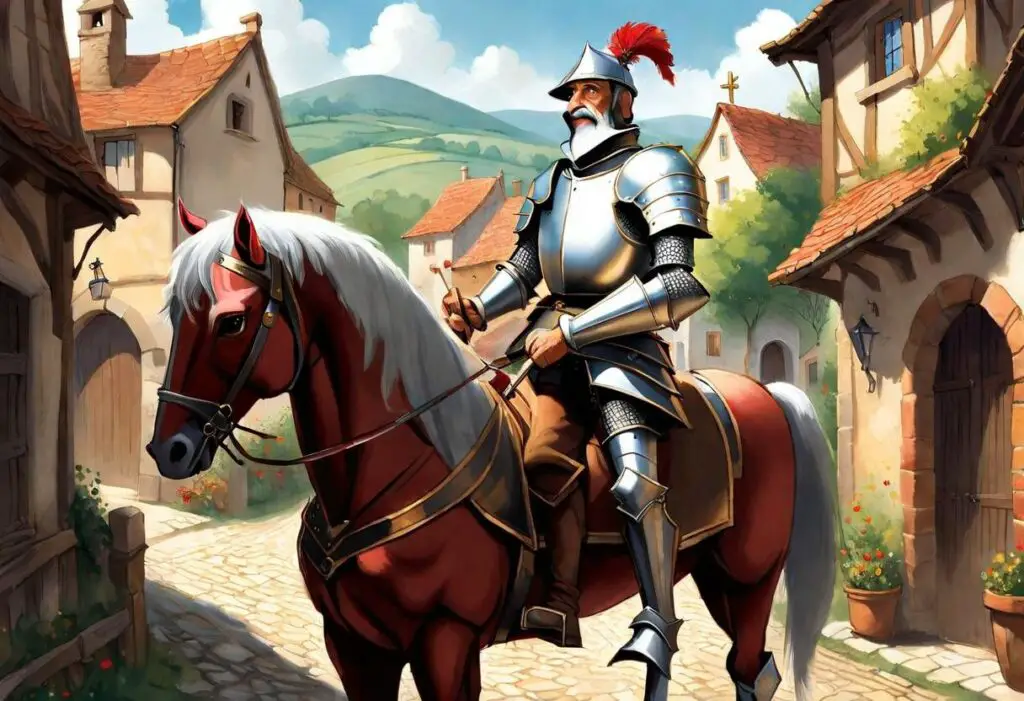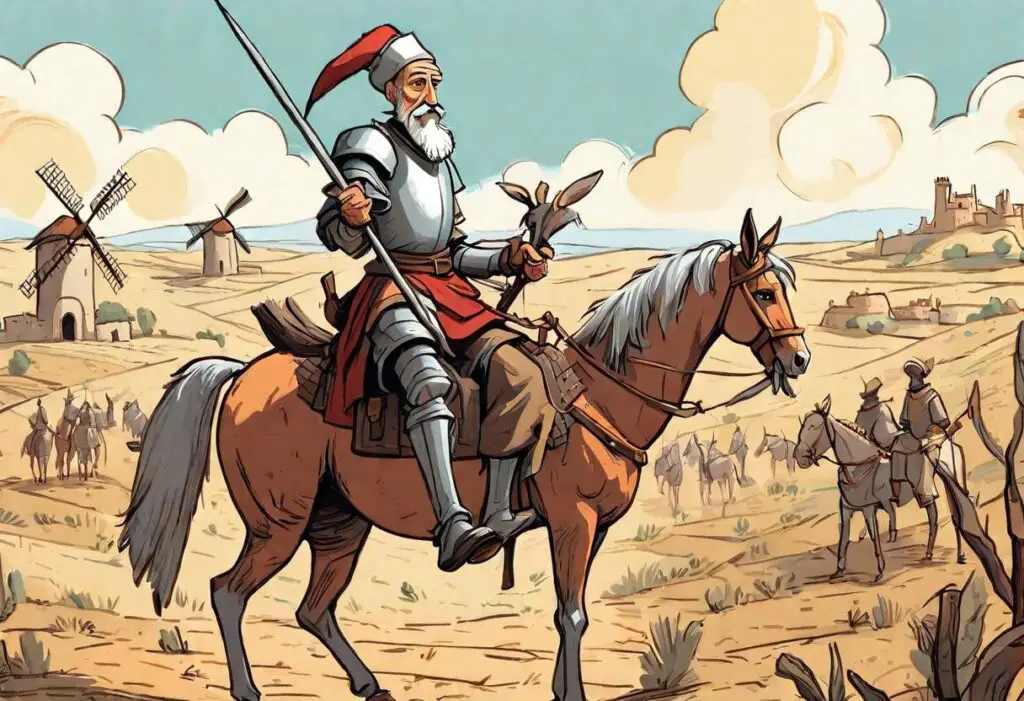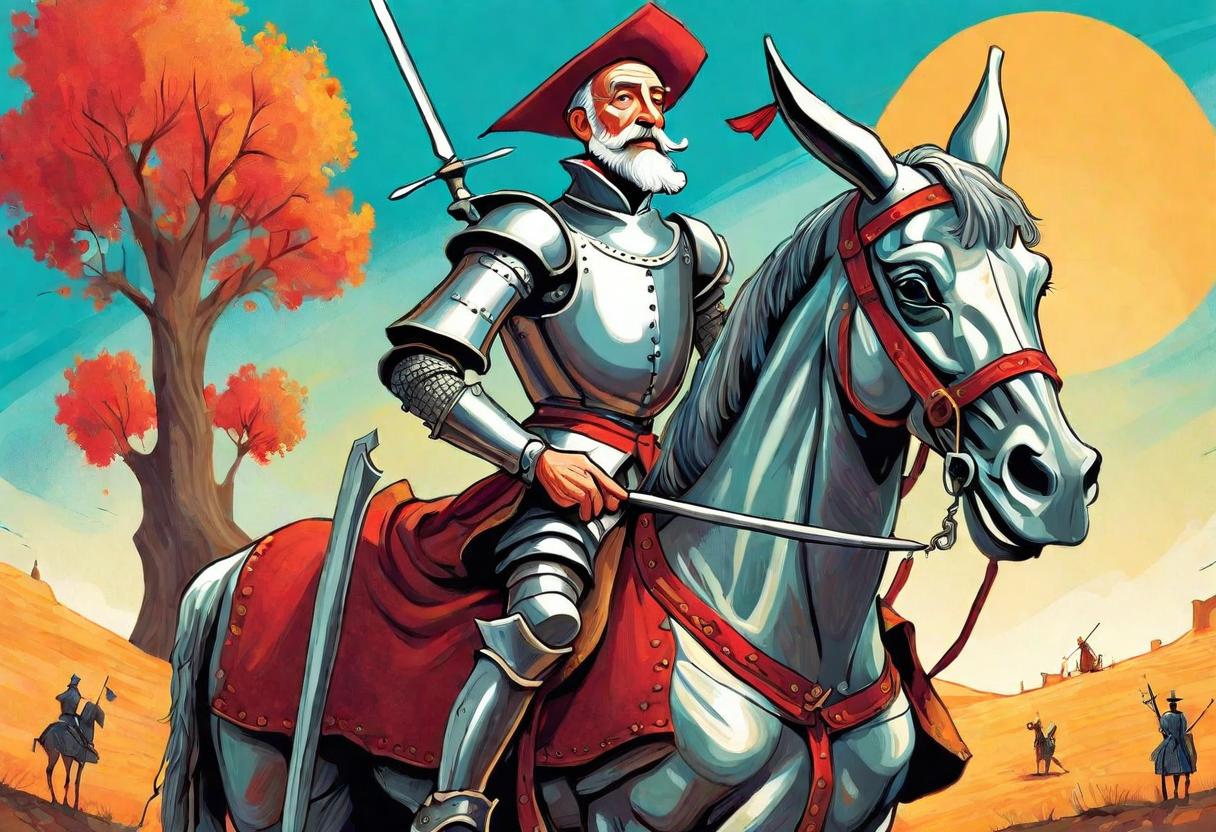Imagine a dusty old man on a tired horse, charging at a giant. As he shouts and raises his lance, he believes he is a brave knight fighting a fearsome enemy. However, as he gets closer, the “giant” reveals itself to be nothing more than a windmill. Consequently, this is one of the most famous and suspenseful scenes in “Don Quixote by Miguel de Cervantes.”

Introduction of Don Quixote:
“Don Quixote by Miguel de Cervantes” is a novel written by Spanish author Miguel de Cervantes. It was first published in two parts, in 1605 and 1615. This novel is one of the most famous books in the world and is considered the first modern novel. “Don Quixote” tells the story of a man who loves reading about knights and their adventures so much that he decides to become one himself. The novel is a mix of humor, adventure, and a touch of sadness, as it shows the gap between dreams and reality.
List of Major Characters:
Don Quixote: The main character, is an old man who believes he is a knight.
Sancho Panza: Don Quixote’s loyal squire, who is a simple farmer.
Dulcinea del Toboso: The lady Don Quixote believes he must defend, though she doesn’t really know him.
Rocinante: Don Quixote’s old and tired horse.
The Priest and the Barber: Friends of Don Quixote who try to bring him back to reality.
Samson Carrasco: A young scholar who tries to cure Don Quixote of his madness by pretending to be a knight.
Summary of Novel: Don Quixote
Part One:
The novel begins with a man named Alonso Quixano, who lives in La Mancha, Spain. He loves reading books about knights and their adventures. He reads so much that he starts to believe that he can become a knight himself. Therefore, he changes his name to Don Quixote and decides to go on adventures to protect the helpless and fight evil.
First, he gets an old suit of armor and names his horse Rocinante. Next, he chooses a simple farmer named Sancho Panza to be his squire, promising him an island to govern as a reward. Additionally, he picks a lady, Dulcinea del Toboso, to be his noblewoman, though she is just a peasant woman who doesn’t know him.

His adventures are mostly comical and end in disaster. For example, he mistakes inns for castles, flocks of sheep for armies, and windmills for giants. Despite his good intentions, he often causes trouble and harm.
Part Two:
In the second part, people in his village learn about his adventures from the first book, which was published. Consequently, they play along with his delusions to make fun of him. Samson Carrasco, a young scholar, pretends to be a rival knight to defeat and make him return home.
Finally, after many more adventures and misadventures, he returns home. He realizes that his dreams of knighthood were just fantasies. Subsequently, he falls ill and renounces his previous ways before dying peacefully.
Themes of the Novel: Don Quixote
Reality vs. Imagination:
The main theme in “Don Quixote by Miguel de Cervantes” is the conflict between reality and imagination. His adventures show how imagination can distort reality, leading to both funny and tragic outcomes.
Idealism vs. Realism:
The novel represents idealism, with his dreams of chivalry and heroism. Sancho Panza, on the other hand, represents realism, with his practical and grounded view of the world. Their interactions highlight the tension between dreams and the harshness of real life.
Social Critique:
The novel also critiques society, showing how people are often cruel and mocking to those who are different. It questions the values of the time and the obsession with social status and appearances.
Major Character Analysis Don Quixote:
Don Quixote
Don Quixote is the heart of the novel. He is kind, brave, and noble but also delusional and impractical. His character shows the power of dreams and how they can inspire or mislead us. Despite his failures, Don Quixote remains a symbol of perseverance and hope.
Sancho Panza
Sancho Panza is loyal and practical. He follows Quixote out of friendship and a bit of greed, hoping for rewards. Sancho’s down-to-earth nature contrasts with his lofty ideals, providing balance and humor to the story.
Dulcinea del Toboso
Dulcinea is the imaginary lady love of Don Quixote. She represents the ideal that Quixote strives to protect, though she never appears in the story. Her character shows how people can create perfect images that are far from reality.
Critical View:
“Don Quixote by Miguel de Cervantes” is praised for its rich storytelling and complex characters. Additionally, it combines humor with deep philosophical questions about life and society. Furthermore, the novel’s influence is vast, inspiring countless other works of literature, art, and even modern media.
For instance, some critics view his madness as a commentary on the power of books and stories to shape our perceptions. On the other hand, others see it as a tragic tale of a man who cannot fit into society’s norms.
Conclusion:
“Don Quixote by Miguel de Cervantes” is a timeless classic that continues to captivate readers with its humor, adventure, and profound themes. Moreover, the story of Quixote and his quest reminds us of the enduring power of dreams and the thin line between reality and imagination. Consequently, this novel remains a cornerstone of literature, celebrated for its innovation and its exploration of the human spirit.
